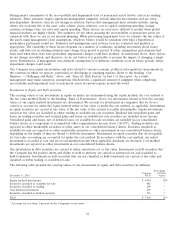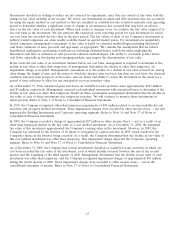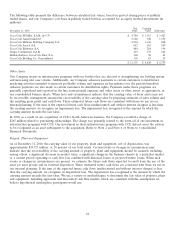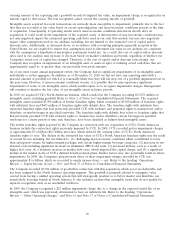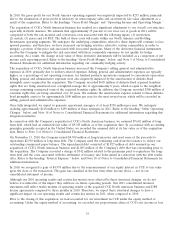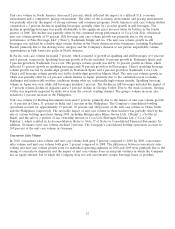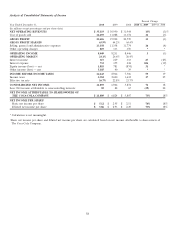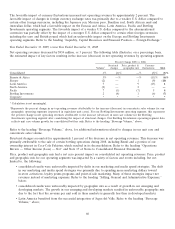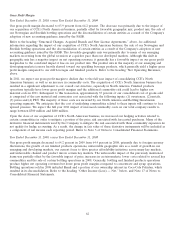Coca Cola 2010 Annual Report Download - page 54
Download and view the complete annual report
Please find page 54 of the 2010 Coca Cola annual report below. You can navigate through the pages in the report by either clicking on the pages listed below, or by using the keyword search tool below to find specific information within the annual report.The operating results of CCE’s North American business are included in our consolidated financial statements effective
October 2, 2010. The operating results of New CCE had no direct impact on the Company’s consolidated financial
statements, since we have no ownership interest in this entity. CCE’s North American business contributed net revenues
of approximately $3,637 million and net losses of approximately $122 million from October 2, 2010 through
December 31, 2010. Furthermore, the Company recorded total assets as a result of the acquisition of $22.2 billion.
Refer to the heading ‘‘Liquidity, Capital Resources and Financial Position,’’ below, for additional information related to
the impact the acquisition had on the Company’s consolidated balance sheet.
On October 2, 2010, the Company also entered into an agreement with DPS to distribute certain DPS brands in
territories where these brands were distributed by CCE prior to our acquisition of CCE’s North American business. The
license agreements replaced agreements between DPS and CCE existing immediately prior to the completion of our
acquisition of CCE’s North American business. Refer to the heading ‘‘Our Business — General,’’ above, and Note 2 of
Notes to Consolidated Financial Statements for additional details related to these new license agreements.
Prior to the acquisition of CCE’s North American business and entering into the DPS license agreements, the
Company’s North America operating segment was predominantly a concentrate operation. As a result of the acquisition
of CCE’s North American business and the DPS license agreements, the North America operating segment is now
predominantly a finished products operation. Generally, finished products operations produce higher net operating
revenues but lower gross profit margins and operating margins compared to concentrate operations. Refer to ‘‘Item 1.
Business — Products and Brands,’’ for additional discussion of the differences between the Company’s concentrate
operations and our finished products operations. These transactions resulted in higher net operating revenues, but lower
gross profit margins and operating margins for the North America operating segment and our consolidated operating
results.
Prior to the acquisition of CCE’s North American business, the Company reported unit case volume for the sale of
Company beverage products sold by CCE. After the transaction closing, we reported unit case volume of Company
beverage products just as we had prior to the transaction.
Prior to the acquisition of CCE’s North American business, the Company recognized concentrate sales volume at the
time we sold the concentrate to CCE. Upon the closing of the transaction, we do not recognize the concentrate sales
volume until CCR has sold finished products manufactured from concentrate to a customer.
The DPS license agreements impact both the Company’s unit case and concentrate sales volume. Sales made pursuant
to these license agreements represent acquired volume and are incremental unit case volume and concentrate sales
volume to the Company. Prior to entering into the license agreements, the Company did not include the DPS brands as
unit case volume or concentrate sales volume, as these brands were not Company beverage products. As mentioned
above, we do not normally consider new license agreements to be structural changes. However, in the case of the DPS
license agreements, given their correlation to our acquisition of CCE’s North American business, we have included the
impact of these license agreements as a structural change when explaining our 2010 financial results.
Since we have determined it is appropriate to include the impact of the DPS license agreements as a structural change,
the total revenues attributable to CCE’s North American business, including DPS, recognized by the Company since the
date of acquisition are considered a structural change.
Prior to the acquisition, we recognized the revenues and profits associated with concentrate sales when the concentrate
was sold to CCE, excluding the portion that was deemed to be intercompany due to our previous ownership interest in
CCE. However, subsequent to the acquisition, the Company will not recognize the revenues and profits associated with
concentrate sold to CCE’s North American business until the finished products manufactured from those concentrates
are sold. For example, in 2010, most of our pre-Easter concentrate sales to CCE impacted our first quarter operating
results. In 2011, we anticipate that most of our Easter-related finished product sales will likely impact our second
quarter operating results. Likewise, in 2010, most of our pre-July 4th concentrate sales to CCE impacted our second
quarter operating results. In 2011, the impact of the July 4th holiday-related finished product sales will likely impact our
third quarter operating results. As a result of this transaction, the Company does not have an indirect ownership
interest in New CCE’s European operations. Therefore, we are no longer required to defer the portion of revenues and
profits associated with concentrate sales to New CCE.
52


